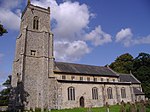Aldborough, Norfolk
Former civil parishes in NorfolkNorfolk geography stubsNorth NorfolkOpenDomesdayVillages in Norfolk

Aldborough is a village and former civil parish, now in the parish of Aldborough and Thurgarton (together with Thurgarton), in the North Norfolk district, in the county of Norfolk, England. It is situated about eight miles (13 km) south of Cromer. The name "Aldborough" derives from the Old English ald (old) and burh (fortification).The civil parish has an area of 7.15 square kilometres and in 2001 had a population of 567 in 259 households, the population increasing to 578 at the 2011 Census.
Excerpt from the Wikipedia article Aldborough, Norfolk (License: CC BY-SA 3.0, Authors, Images).Aldborough, Norfolk
The Green, North Norfolk Aldborough and Thurgarton
Geographical coordinates (GPS) Address Nearby Places Show on map
Geographical coordinates (GPS)
| Latitude | Longitude |
|---|---|
| N 52.862 ° | E 1.242 ° |
Address
The Green
The Green
NR11 7NX North Norfolk, Aldborough and Thurgarton
England, United Kingdom
Open on Google Maps









